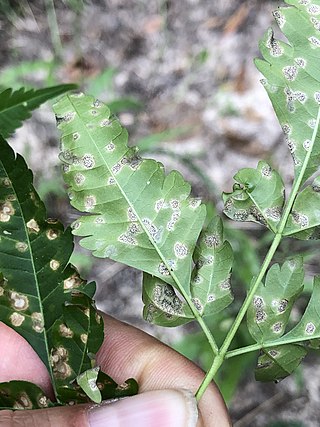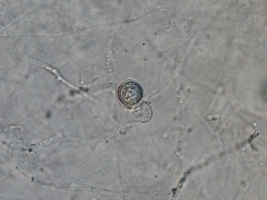
Pythium is a genus of parasitic oomycetes. They were formerly classified as fungi. Most species are plant parasites, but Pythium insidiosum is an important pathogen of animals, causing pythiosis. The feet of the fungus gnat are frequently a vector for their transmission.

Pythiosis is a rare and deadly tropical disease caused by the oomycete Pythium insidiosum. Long regarded as being caused by a fungus, the causative agent was not discovered until 1987. It occurs most commonly in horses, dogs, and humans, with isolated cases in other large mammals. The disease is contracted after exposure to stagnant fresh water such as swamps, ponds, lakes, and rice paddies. P. insidiosum is different from other members of the genus in that human and horse hair, skin, and decaying animal and plant tissue are chemoattractants for its zoospores. Additionally, it is the only member in the genus known to infect mammals, while other members are pathogenic to plants and are responsible for some well-known plant diseases.

Take-all is a plant disease affecting the roots of grass and cereal plants in temperate climates caused by the fungus Gaeumannomyces tritici. All varieties of wheat and barley are susceptible. It is an important disease in winter wheat in Western Europe particularly, and is favoured by conditions of intensive production and monoculture.
Pythium irregulare is a soil borne oomycete plant pathogen. Oomycetes, also known as "water molds", are fungal-like protists. They are fungal-like because of their similar life cycles, but differ in that the resting stage is diploid, they have coenocytic hyphae, a larger genome, cellulose in their cell walls instead of chitin, and contain zoospores and oospores.
Pythium ultimum is a plant pathogen. It causes damping off and root rot diseases of hundreds of diverse plant hosts including corn, soybean, potato, wheat, fir, and many ornamental species. P. ultimum belongs to the peronosporalean lineage of oomycetes, along with other important plant pathogens such as Phytophthora spp. and many genera of downy mildews. P. ultimum is a frequent inhabitant of fields, freshwater ponds, and decomposing vegetation in most areas of the world. Contributing to the widespread distribution and persistence of P. ultimum is its ability to grow saprotrophically in soil and plant residue. This trait is also exhibited by most Pythium spp. but not by the related Phytophthora spp., which can only colonize living plant hosts.
Alternaria japonica is a fungal plant pathogen. It is a cause of black spot disease in cruciferous plants. It is not a major source of crop loss, but is considered dangerous for plants during the seedling stage.

Macrophomina phaseolina is a Botryosphaeriaceae plant pathogen fungus that causes damping off, seedling blight, collar rot, stem rot, charcoal rot, basal stem rot, and root rot on many plant species.
Pythium aphanidermatum is a soil borne plant pathogen. Pythium is a genus in the class Oomycetes, which are also known as water molds. Oomycetes are not true fungi, as their cell walls are made of cellulose instead of chitin, they are diploid in their vegetative state, and they form coenocytic hyphae. Also, they reproduce asexually with motile biflagelette zoospores that require water to move towards and infect a host. Sexually, they reproduce with structures called antheridia, oogonia, and oospores.
Pythium graminicola is a plant pathogen infecting cereals.
Pythium myriotylum is a soil-borne oomycete necrotroph that has a broad host range, this means that it can infect a wide range of plants.
Sclerophthora macrospora is a protist plant pathogen of the class Oomycota. It causes downy mildew on a vast number of cereal crops including oats, rice, maize, and wheat as well as varieties of turf grass. The common names of the diseases associated with Sclerophthora macrospora include "crazy top disease" on maize and yellow tuft disease on turf grass. The disease is present all over the world, but it is especially persistent in Europe.

Pseudocercospora subsessilis is a fungal plant pathogen infecting chinaberry tree. It is widespread in tropical and subtropical areas on host species of the genera Azadirachta and Swietenia.
Bipolaris cactivora is a plant pathogen causing cactus stem rot and pitaya fruit rot.
Pythium dissotocum is a plant pathogen infecting strawberry and rice.

Pythium sulcatum is a chromalveolate plant pathogen infecting carrots. Because this organism was once thought to be a type of fungus, it is still often treated as such.

Didymella bryoniae, syn. Mycosphaerella melonis, is an ascomycete fungal plant pathogen that causes gummy stem blight on the family Cucurbitaceae, which includes cantaloupe, cucumber, muskmelon and watermelon plants. The anamorph/asexual stage for this fungus is called Phoma cucurbitacearum. When this pathogen infects the fruit of cucurbits it is called black rot.
Pyrenochaeta terrestris is a fungal plant pathogen that infects maize, sweet potatoes, and strawberries. This plant pathogen causes a disease in onion that is commonly called pink root. P. terrestris is also known to infect shallots, garlic, leeks, chives, cantaloupe, carrots, cauliflower, cowpea, cucumbers, eggplants, lima beans, millet, oats, peas, peppers, potatoes, spinach, sugarcane, and tomatoes.

Fusarium solani is a species complex of at least 26 closely related filamentous fungi in the division Ascomycota, family Nectriaceae. It is the anamorph of Nectria haematococca. It is a common soil fungus and colonist of plant materials. Fusarium solani is implicated in plant diseases as well as in serious human diseases such as fungal keratitis.
Tobacco necrosis virus A (TNV) is a plant pathogenic virus of the family Tombusviridae.

Melon necrotic spot virus (MNSV) is a virus that belongs to the genus Gammacarmovirus of the family Tombusviridae. It has been observed in several countries of the Americas, Africa, Asia, and Europe. It is considered to be an endemic virus in greenhouses and field productions of Cucurbitaceae crops, including melon, cucumber, and watermelon. MNSV is mainly spread through infected soil, seedlings, insects, and by the root-inhabiting fungus vector Olpidium bornovanus. Symptoms vary between Curbitaceae crops, but generally consist of chlorosis, brown necrotic lesions, leaf wilt, fruit decay, and plant death. Management of the disease consists of preventing infection by rotating fields and crops, steam sterilization, and disposal of infected plants. Also, treated seeds with heat or chemicals are efficient in preventing infection. MNSV is important in melon plants as it causes vast economical damage worldwide reducing significant yields.








